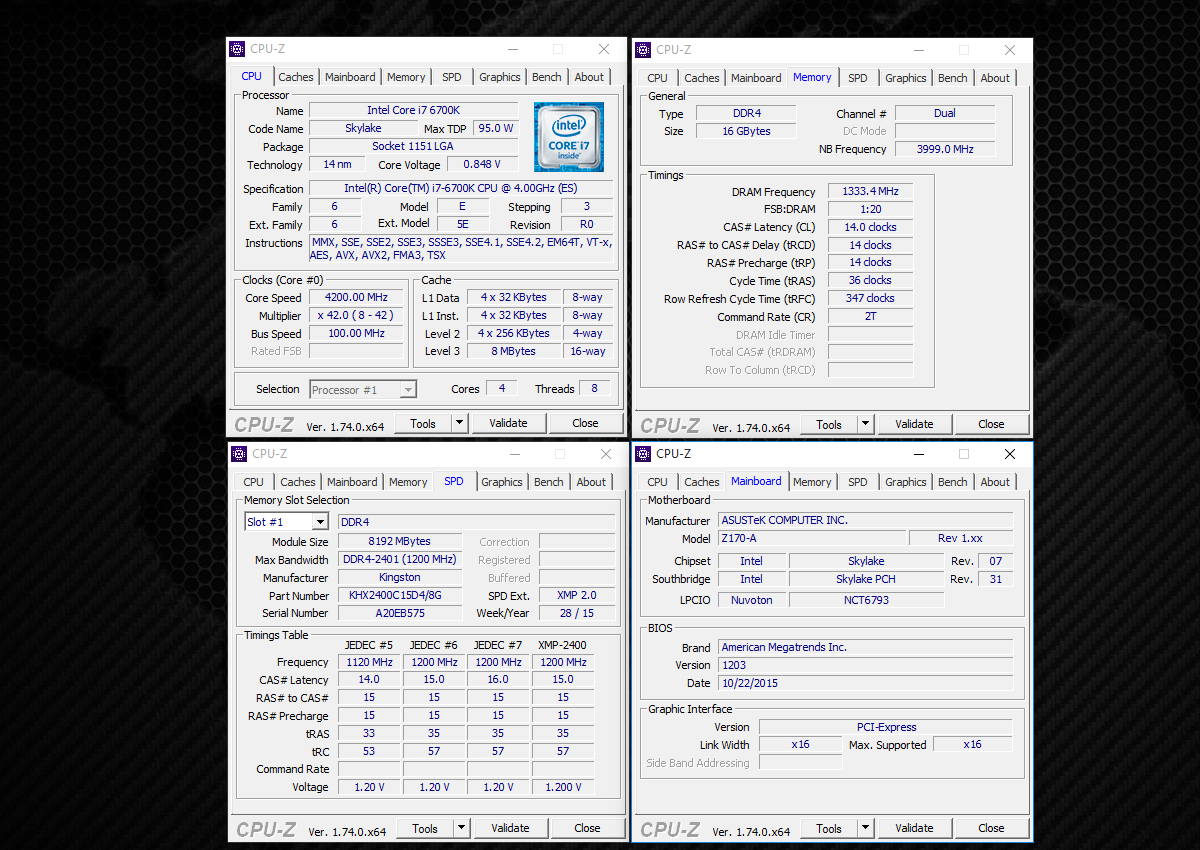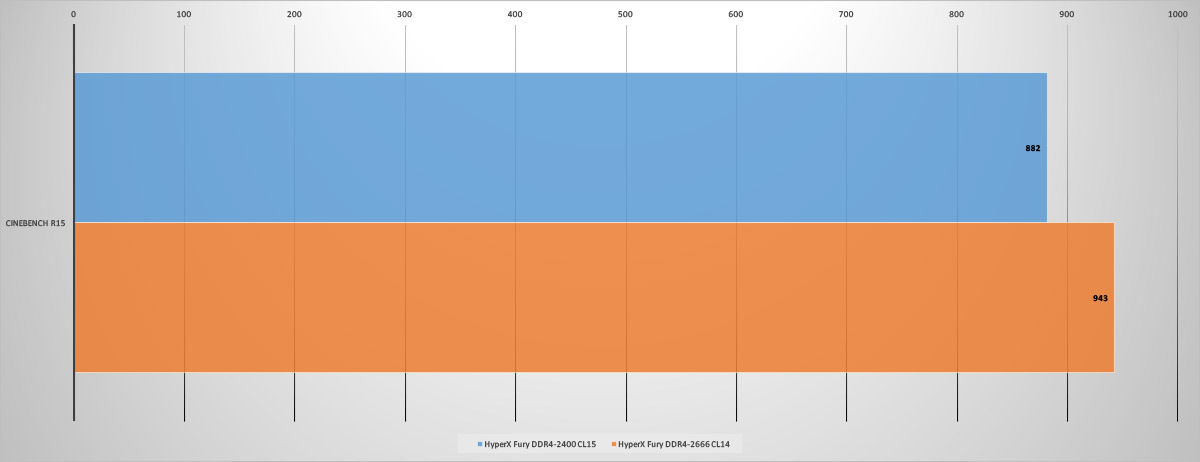HyperX Fury DDR4-2400 16 Gb RAM Kit Overview (2 * 8 Gb)
Hello Giktayms! It has been repeatedly predicted that the memory position of the DDR4 standard will be dominant by 2016. At the end of 2015, there are no prerequisites for total superiority, but more and more users, grinding their teeth and counting their money, are acquiring new Intel motherboards and processors, and with them new memory. What does HyperX offer in this sector of the market? Under the cat, I’m dealing with a set of two 8-gigabyte strips of HyperX Fury DDR4-2400.
The analysis of technical features has already been made many times and by many respected publications and authors, in particular, in the Kingston company’s blog on GeekTimes, according to the old tradition, I will reserve the role of a practitioner.


Not the simplest components, it could have been more modest, but the essence of the question is different - is the HyperX Fury memory good and if it gets overwhelmed it will make it even better?
A few words about the memory modules themselves:
HyperX Fury DDR4 is the youngest line of HyperX, which is made for users of the mass segment and the Intel SkyLake platform.
The strips used SK Hynix chips labeled MFR . The nominal frequency for them is 2133 MHz with CL15 timings. These are the same chips as in the top HyperX Predator, but the selection procedure (not quite natural) allows you to squeeze a little more from some chips or get more modest results from others.


After a simple setup procedure in BIOS and easy shamanism, the frequency of 2400 MHz turned into 2666 MHz (completely free). Moreover, the main timings pulled up a bit from 15-15-15-35-2T to 14-14-14-14-36-2T and all this without increasing the operating voltage. Incidentally, you will have a saying about gunpowder in powder flasks.


What to say about looks? So far, HyperX Fury DDR4 flaunts only in black, unlike the Fury DDR3 - for me it is a matter of time and soon there will be different color solutions on the shelves. Paint radiators in white, blue and red is not difficult, and for many users it will bring sincere joy.
You can evaluate performance only by comparison, otherwise it will not be clear why to overclock something or upgrade an already fast (in your coordinate system) game system.
The test programs and utilities were selected as follows:
What happened as a result:

Overclocking provides a more than tangible increase - about 10 percent for all operations. It has long been known that it is better to be rich and healthy than poor and sick, which is why an increased frequency and lower timings help in productivity.

Practical application (rendering of three-dimensional scenes) also responds positively to memory manipulations, hence the increase is quite comparable to what turned out in the AIDA64 test.

There is a dependence on the memory speed, but it is not very large; rather, optimizations of the processor architecture and increased clock speed will play in this kind of test.
The first and most important conclusion: if you have already bought a productive memory - do not rush to leave it in the nominal mode. In the case of my HyperX Fury DDR4 kit, it became possible to get about 10 percent more system performance for the same money.
The second conclusion - since most of the top-end kits are assembled on the same chips - do not chase memory that is already ready for operation at a frequency of 4000 MHz. Maybe you should try your hand at acquiring 3000 MHz or even lower frequencies?
The third conclusion is that in the RAM market (both general and for enthusiasts), HyperX remains a significant quantity, even despite the formal absence of superhigh results in overclocking DDR4 modules.

Test stand
- Processor: Intel Core i7-6700K
- Motherboard: ASUS Z170-A
- RAM: Kingston HyperX Fury DDR4-2400 16 Gb (2 * 8 Gb)
- System SSD: HyperX Predator PCI-E SSD 480 Gb
- Video Card: AMD Fury X reference design
- Power Supply: Corsair AX1200i, 1200W
- Operating System: Windows 10 Professional (64-bit)

Not the simplest components, it could have been more modest, but the essence of the question is different - is the HyperX Fury memory good and if it gets overwhelmed it will make it even better?
A few words about the memory modules themselves:
HyperX Fury DDR4 is the youngest line of HyperX, which is made for users of the mass segment and the Intel SkyLake platform.
The strips used SK Hynix chips labeled MFR . The nominal frequency for them is 2133 MHz with CL15 timings. These are the same chips as in the top HyperX Predator, but the selection procedure (not quite natural) allows you to squeeze a little more from some chips or get more modest results from others.


After a simple setup procedure in BIOS and easy shamanism, the frequency of 2400 MHz turned into 2666 MHz (completely free). Moreover, the main timings pulled up a bit from 15-15-15-35-2T to 14-14-14-14-36-2T and all this without increasing the operating voltage. Incidentally, you will have a saying about gunpowder in powder flasks.


What to say about looks? So far, HyperX Fury DDR4 flaunts only in black, unlike the Fury DDR3 - for me it is a matter of time and soon there will be different color solutions on the shelves. Paint radiators in white, blue and red is not difficult, and for many users it will bring sincere joy.
You can evaluate performance only by comparison, otherwise it will not be clear why to overclock something or upgrade an already fast (in your coordinate system) game system.
The test programs and utilities were selected as follows:
- AIDA 64 5.50.3600
- Cinebench r15
- x.264 HD benchmark 5.0.1
What happened as a result:
The first picture. AIDA 64 5.50.3600

Overclocking provides a more than tangible increase - about 10 percent for all operations. It has long been known that it is better to be rich and healthy than poor and sick, which is why an increased frequency and lower timings help in productivity.
The second picture. Cinebench R15

Practical application (rendering of three-dimensional scenes) also responds positively to memory manipulations, hence the increase is quite comparable to what turned out in the AIDA64 test.
The third picture. x.264 HD benchmark 5.0.1

There is a dependence on the memory speed, but it is not very large; rather, optimizations of the processor architecture and increased clock speed will play in this kind of test.
conclusions
The first and most important conclusion: if you have already bought a productive memory - do not rush to leave it in the nominal mode. In the case of my HyperX Fury DDR4 kit, it became possible to get about 10 percent more system performance for the same money.
The second conclusion - since most of the top-end kits are assembled on the same chips - do not chase memory that is already ready for operation at a frequency of 4000 MHz. Maybe you should try your hand at acquiring 3000 MHz or even lower frequencies?
The third conclusion is that in the RAM market (both general and for enthusiasts), HyperX remains a significant quantity, even despite the formal absence of superhigh results in overclocking DDR4 modules.
